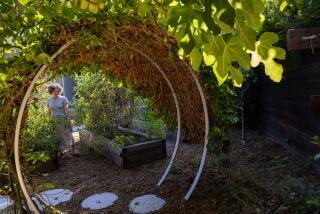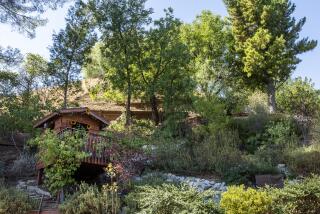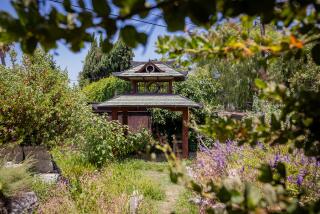Making More of Less : All it takes is proper planning to add mock mountain streams, patios, and even lap pools to small back yards.
- Share via
Victor Garcia often winds up his day by visiting his favorite High Sierra stream, letting the murmur of water roiling over the rocky stream bed sooth away tensions and relax him like no pill or potion ever could.
And Garcia, who lives in Orange, doesn’t even have to back his car out of the driveway to get there.
The “stream” is in his back yard--an artfully sculpted and painted concrete copy of a granite watercourse he stumbled on one day while wandering around the periphery of Lake Sabrina near Bishop on the eastern slope of the Sierra Nevada mountains.
But while the original takes up acres, Garcia--who learned to make rocks as an offshoot of his swimming pool business--has packed his copy into a relatively small 900-square-foot area of his back yard.
The rear yard in Garcia’s 35-year-old custom-built home in central Orange is bigger than the yards most home builders supply with their products nowadays. His mountain stream, however, provides a classic example of how much can be tucked into a relatively small space--a 30-foot square in this case.
Making use of spaces that small, sometimes even smaller, is a task that confronts and often daunts growing numbers of homeowners, landscaping professionals say.
The rub? It really doesn’t have to be hard.
There’s no big secret to successfully landscaping a small back yard, as long as a few simple but critical rules are followed, says Dale Rahn, an executive with Village Nurseries in Orange who heads the new native landscape restoration division. A landscape architect, he formerly ran Village’s eight-nursery landscape centers division.
“To start, you need to define your needs. No landscape plans work without beginning this way,” he said.
If your pets are paramount, the yard design needs to provide plenty of space for them to run, swim, fly, creep, burrow or bask--whatever their nature demands.
If you entertain, a patio and outdoor cooking area should come first--with the rest of the yard planned to complement it.
If the yard--or your budget--is too small for a patio, try a meandering flagstone or brick walkway through the yard and let it widen out in several places to accommodate seating, a barbecue and a knockdown table that can be stored in the garage when not in use.
For active athletic types, even the narrowest of back yards can be fitted with a lap pool or dry-land exercise area.
Reading and resting more your thing? A small gazebo with an upholstered seat; an inviting wooden bench secluded behind an espaliered flowering vine; a cast-iron table and chair shaded by the showy pink umbrella of a crape myrtle in full bloom; or a compact deck looking out onto a seemingly structureless rock garden or a strikingly formal rose garden--all are possible in spaces as small as the smallest postage-stamp lot in a condominium complex.
Once you know what you need--and remember, that often can be at odds with what you initially think you want--the next rule is to chose the type of look you want to create, and what level of maintenance you are willing to put up with.
And one thing to remember: back yards no longer have to include lawns. There is no rule, no local law, not even much of a custom any longer, that says a flat grassy plot is a must.
Lawns can be wonderful; they certainly make better play areas for kids--and grown-ups--than gravel, concrete, rose beds or cactus gardens, but they don’t have to be there just because you’ve got a yard.
*
Freeing people from the lawn mentality is one good thing about the trend toward smaller back yards, says Barbara Brinkerhoff, a landscape designer and principal of Lifescapes, a Newport Beach-based landscape architecture firm.
Beyond the ever-popular swimming pool, spa, patio and cookout area, Brinkerhoff said she is seeing a growing interest in low-maintenance landscape schemes for residences.
These plans don’t necessarily use only drought-tolerant plant materials. They often combine compact or dwarf varieties of plants with timer-controlled drip irrigation systems and other effects such as decomposed granite walkways or flagstone or slate patios to reduce water consumption, weed growth and the time the homeowner must spend keeping everything trimmed and cleaned up.
“One really nice thing about the dwarf plants is that they can grow without being trimmed back all the time, so you have a nice unstructured natural look and less maintenance,” Rahn said.
Like Rahn, Brinkerhoff says that deciding what you need is the first and most important step in designing for a small back yard--because there is less room for extras, every inch of a small yard is critical.
“The exterior should be looked at the same as the interior,” she said. “One should flow into the other.”
At its simplest, that means don’t place a pool where wet-footed swimmers will have to re-enter the house through a carpeted living or family room. It also means you should keep public areas like pools and playgrounds away from private rooms like studies and home offices. And it means you should situate like uses together--an outdoor eating area is a natural extension of a dining room, but often looks odd and doesn’t work well off the master bedroom.
Architecturally, the design of a yard doesn’t have to match the house--complementing features will do.
“California is a place where you can create hybrids,” said landscape architect Roger Voettiner, senior principal at Lifescapes. “You don’t want a hodgepodge, so all the elements should fit, but there is no rule that says a Mediterranean-style home has to have a Mediterranean landscape.”
*
Whatever the overall design, one feature most people want in their landscaping, even if they think they cannot afford it, is water. In pools, fountains, falls, ponds or streams, water is the most consistently requested design feature, landscape professionals say.
“They have done studies that show that the first place stressed-out urban dwellers head when they need relief is to a viewpoint that features some sort of water,” said Rahn.
“It can be a spot overlooking a waterfall or the surf or a stream, but what seems to be important is the sight and sounds of water. They are among the best stress relievers around.”
So if a water element is important but out of your budget, Rahn said, you should plan a yard that can be done in increments, as the cash becomes available. The area that one day will be taken up by a pool or fountain can be a garden, a children’s play area or even a patch of lawn until then.
One way to get water effects for minimal expense is to install a small recirculating fountain as a central element of the back yard--put it on a patio, in the garden surrounded by plants or next to your gazebo or other secluded getaway spot.
It is also possible to get the feel of water without the expense--or maintenance--with a dry stream landscape.
Josh Hard has been putting them in around Orange County for almost two years now and the Anaheim man--still a college student--says his word-of-mouth business has grown so large that he is about to formalize it with a company he will call Native Landscape Construction.
Hard works with native and Mediterranean plant materials which, by their nature, are drought-resistant. He works them into water-saving ecosystem designs that use drip irrigation and frequently feature a dry stream as a centerpiece.
“It gives you the feel of water, especially in the morning after the sprinklers have watered down the rocks and gravel and it is all wet and shiny. But the cost is a lot less and there is little maintenance,” Hard said. “And it is a lot nicer and more relaxing than a wet, steamy lawn on a hot summer day.”
Hard said he learned to build natural-appearing stream beds as an employee of a company that specializes in building rock formations from concrete-covered wire forms.
But the rocks in his own creations are real river rocks that he obtains from a supplier in San Bernardino County.
After laying out the course of the stream, Hard moves whatever dirt he needs in order to get a foot or more of elevation at the head or start of the bed. He then digs out the shape of the stream and lines it with concrete. He adds a base of decomposed granite and over that spreads the visible part of the bed--a layer of river pebbles mixed with pea gravel and coarse sand.
“Then I place the boulders that I’ve selected,” he said. “I put them in natural places, like you’d see in a real river bed. So I’ll usually have a big one stopped by several smaller ones that are jammed under its base, just like it had tumbled down from the mountains. I go to a lot of rivers and take a lot of pictures and stare a lot.”
He has found that narrow, deep beds look better--more dramatic and more natural--than wide, shallow ones. And he has learned that realism demands a foot or more of drop from start to finish, formed by a series of rock “steps” that would be tiny waterfalls if water ran in his streams.
*
In Victor Garcia’s streams, water does run. It tumbles down an eight-foot rock waterfall that splits into three rocky streams that in turn empty into a series of two pools before the recirculating pump sucks it all back uphill for another circuit.
Garcia used the incremental approach to his project. In 1983, to prove to himself that he could do it, he built a four-foot waterfall in a corner of his back yard. The water tumbled down man-made rocks into two pools--one a heated whirlpool, the other a cool-down pool. He also built a patio of Bouquet Canyon flagstone from Arizona.
Around the waterscape he planted several fast-growing pines (the tallest is more than 30 feet tall today) and what he now calls “a normal, regimented, California back-yard landscape, with things like agapanthus and pansies.”
Last year, Garcia flexed his expanded rock-building skills by doubling the height of the waterfalls and adding stream beds on each side.
In all, he said, he used nine tons of sand and concrete--two tons in 1983 and seven more last year--all mixed on site.
He built the formation with reinforcing rod and metal lathe, forming the rough shapes with chunks of broken concrete and then wrapping that with the metal rods and wire and applying wet concrete with a hand trowel to get the final shape. The cracks, crevasses and crannies that make the concrete look like granite from the Sierra Nevada were molded into the wet concrete with latex masks Garcia made from real rocks.
The entire construction was then coated with waterproofing and Garcia sat down with a basket of tiny paintbrushes and nine different colors of masonry paint to color the rocks so they look as natural as if he had taken them from a Sierra stream.
“That was the hardest part,” Garcia said. “It can take up to three hours to paint one three-foot-diameter rock, and I made a lot of them.”
Colors on each rock include red, white, gray, tan, orange, green, black, purple and blue, mostly applied as tiny specks that are barely visible as individual colors unless examined from only inches away.
He also ripped out his original landscaping, except for the now well-established pines, and replanted to obtain a native landscape look.
Plants include a screen of cottonwood trees along the rear fence line with gnarled manzanita bushes and dark green chain ferns on the rock slopes and pockets of red-flowered penstemon and California poppies adding color to the scheme.
All it takes is proper planning to add mock mountain streams, patios, even lap pools to small back yards.






